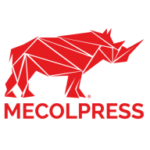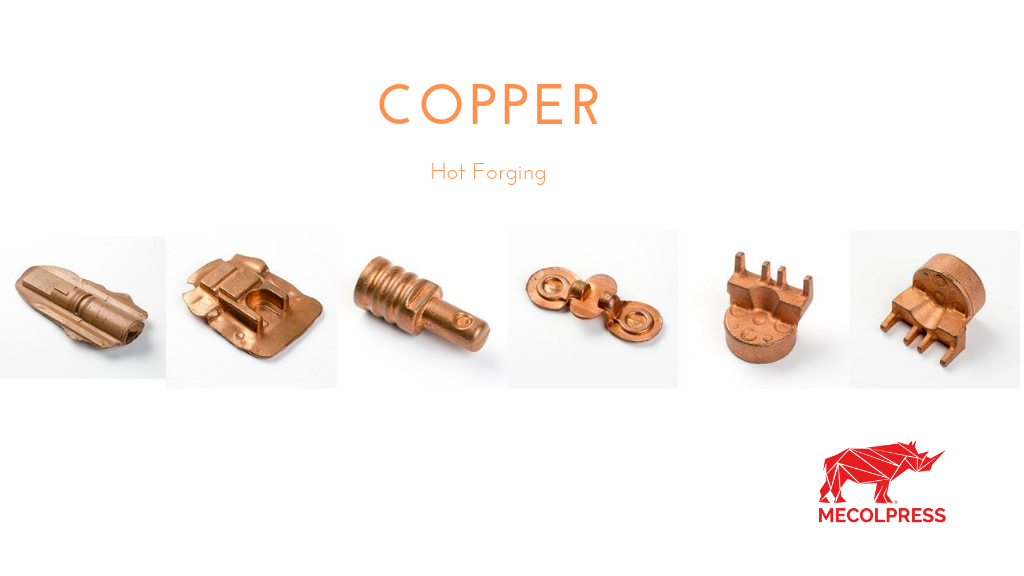
Copper hot forging: Mecolpress presses
Mecolpress proposes a wide variety of mechanical and hydraulic presses for copper hot forging. Thanks to Mecolpress technology it is possible to obtain geometrical shapes, even the most complex ones, and to check all the process steps.
Mecolpress boasts a very long experience in the hot forging presses field and proposes to its customers a wide variety of presses with which it is possible to realize different pieces with simple and complex geometrical shapes. One of the most commonly used material by our customers for the hot forging is copper.
Copper features
This material is known for its conductivity features and it is especially indicated for the forging of parts used in the electric sector such as for example parts for switches, for connectors, battery clips, plates for heating dissipation of electrical parts.
The billets forging temperatures for copper are around 800°C, while the die temperatures are about 300°C.
Presses for copper hot forging: the Mecolpress solutions
The copper alloys are certainly expensive and for this reason it is necessary to optimize the productivity of the used press. Our sales department, according to the alloy used by the customer companies and to the geometrical shapes intended to obtain, is available to suggest which are the most recommended presses for copper hot forging.
Moreover, our customers, in case of needs, can commission us also the die to associate to the requested press.
Strength of Mecolpress is to be able to offer to its customers a forging test in very short time so that to verify with which forces it is necessary to operate to make the best use of the press.
To learn more about our range of presses for copper hot forging you can contact our sales department.
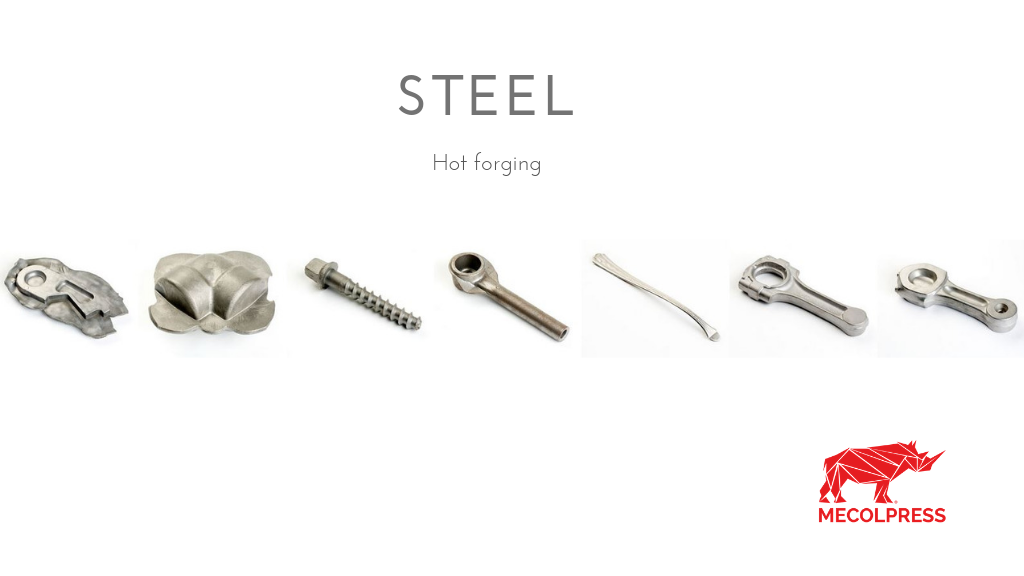
Steel hot forging: Mecolpress solutions
Mecolpress boasts a very long experience as producer of mechanical and hydraulic presses for the realization of hot forged steel parts. For a complete and detailed overview of our presses, please contact our sales department.
For the hot forging of steel parts, it is possible to use mechanical or hydraulic presses according to the geometrical complexity of the part to be forged and to the features of the specific alloy used for the forging.
Steel features
Steel is well-known for being a material having a considerable mechanical resistance and this characteristic makes it a material suitable for innumerable application sectors, including construction industry, automotive and railway sector.
Through the mechanical and hydraulic Mecolpress presses, it is possible to realize different types of parts, including for example screws and valves.
Steel hot forging presses
Mecolpress proposes to its customer companies different presses both mechanical and hydraulic for steel hot forging.
During the forging process of this material it is necessary to pay attention to the used energies and temperatures. Regarding the forging temperature of the billets, at presence of steel alloys, this goes approximately from 1.000°C to 1.200°C. The dies temperature is about 300°C, instead.
Moreover, during the steel hot forging process it is necessary to use the right lubricants in order not to wear the die and to optimize the production.
During the hot pressing of steel, the right lubricants must also be used in order to facilitate the flow of the material and the detachment of the same from the die. Mecolpress equips its presses with automatic lubrication systems with fixed or mobile points according to the specific application and in order to optimize the production process.
Our sales department remains at customer’s disposal to suggest the most suitable press to the production specific needs and, in addition, in the after-sale step it is possible to take advantage of a customized training course against payment, in order to learn all the tricks to make the best use of the bought press according to the production type.
The production cycle can be carried out completely automatically or manually according to the customer’s specific requests.
All the screw presses are customizable according to customer needs.
For further information you can contact our sales managers.
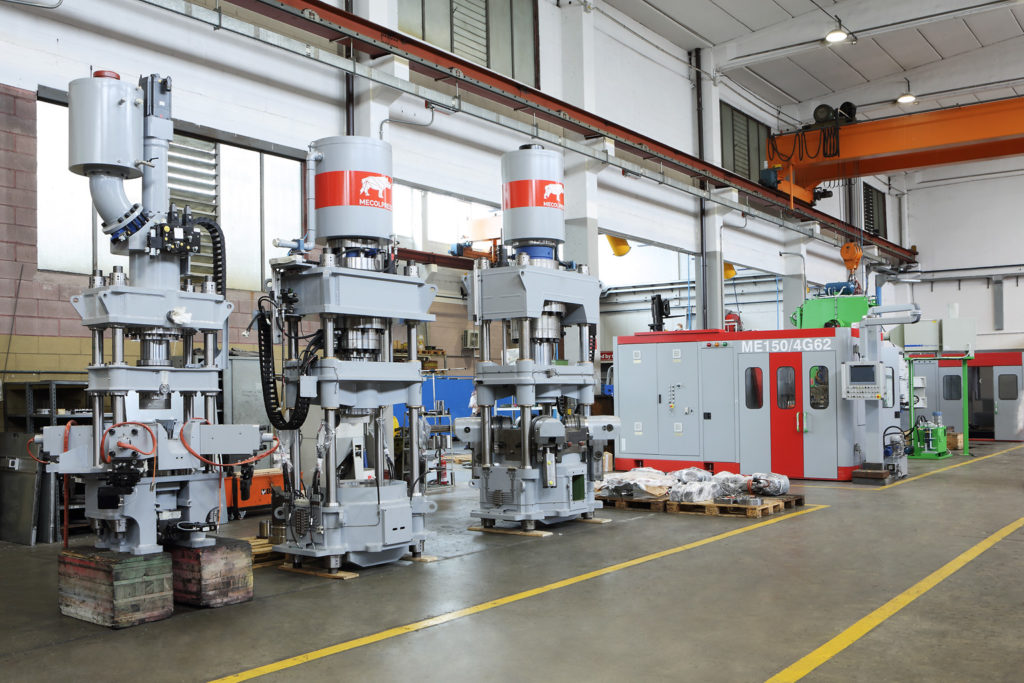
Mecolpress hydraulic presses solve problems
Choosing the hydraulic presses of ME series for brass hot forging not only gives a technical advantage, but it can also represent a competitive advantage for your Company for the responsiveness on the market and for the speed your Company can reacts with to the unexpected necessities of the market.
This is the case of a customer of ours, Italian, based in Brescia, brass forger as subcontractor supplier for many years, with an increasing success thanks to the long experience of both the Company management and of the people in charge of the productive departments, first and foremost the brass hot forging one.
Experience and availability anytime
For years, quietly, without overdoing, but with perseverance and professionalism, our customer could manage optimally the different situations of the group, between forging and mechanical machining. Even if he is always looking for the hardest, most technical and logistic challenging orders, he could gain his position of full respect in the panorama of subcontractors (that are many in our province).
And in order to keep a high level of service and to receive in return a high loyalty of the customers, sometimes it is necessary to be able to take important decisions, in a very short time.
It happened so: in mid-November 2018, 15 days after they ordered us a 450 tons continuous cycle mechanical eccentric press, our customer had a meeting with one of his most important German customers, a very well-known company in the heating sector and civil hydraulic plants, who put on the table a series of new parts, in a brass alloy they invented, for which no one had forging experience.
In short, a challenge for our customer:
“These are the new parts to produce, the sizes go from the small junction to the one that weights various kilos, and if you want the order you must be able to produce the whole range, and be ready to start in very short time”
The customer came to us asking indications on the forging technique for this alloy with high copper content, in order to know which press and which energies are necessaries, but also which furnace and which temperature would be necessary.
Our reaction was making available what we always have in our company, since we are always ready for these eventualities: hot forging presses, induction and gas heating furnaces, and obviously all the collaboration of our staff. We immediately organized some forging tests and realized first samples of the parts: thanks to Calipso system for process data collecting and analysis, our customer could understand which forces and temperatures are needed for forging this special copper alloy.
Last minute solution of Mecolpress
All this process has also led to understand that the new press just ordered by our customer would not be suitable for these products, that in order to be efficiently forged, need an accurate check of the material flow in the die.
The solution? Turning the order of an eccentric press at continuous cycle into a hydraulic press of ME series, that thanks to its construction technology and to a sophisticated software, permits a total programming of the forging process.
Moreover, at Mecolpress the hydraulic presses are available with very short delivery time, even starting from 4 weeks for some models. This happens because, with the market experience we have accumulated in years and after many sold presses, we are able to anticipate the customer’s needs and to have quite ready the presses we will sell in the future.
Then, our customer could go back to his German customer and confirm him that just in 3 months from the date of their first meeting, he would be able to satisfy him, with a new forging line, at high technology, dedicated to his product and able to grant the quality of the forged parts.
A won challenge for our customer, and a satisfaction for us for having helped him and to reinforce his imagine of supplier of very high reliability among his customers.
Are you also in such a similar situation and do you have to face new requests presenting some criticalities?
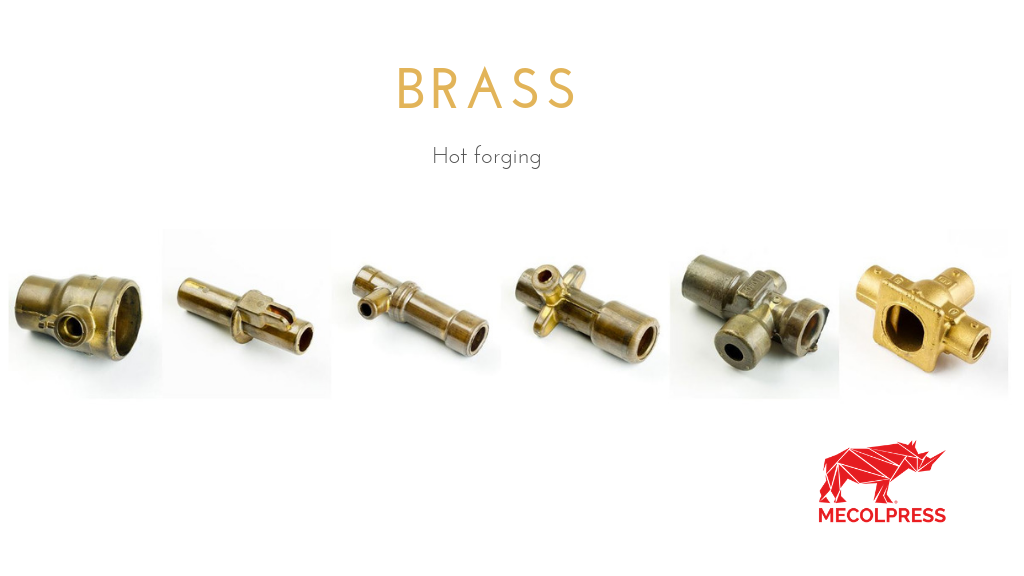
Hot forging of the brass: advantages of this material
The brass and its characteristics
The brass is an alloy composed of lead, copper, zinc and other metals, whose percentage can vary. The main component of this alloy is the copper that has a percentage between 55% and 62%. This high content of copper makes the brass a good electricity conductor and a material of easy mechanical machining because it does not wear out the cutting tools quickly as it instead happens for iron or steel.
Other typical features of the brass are:
- Recycling ease: brass is often remelt and reused to produce new parts.
- Resistance to a wide temperature range: during the hot forging process the brass is able to support, without creating particular critical issues, a moderate temperature range, this simplifies considerably the work, allowing a major tolerance in the usage of machineries.
- Lacking oxidation: During the heating phase inside the die, this metal is not subject to considerable oxidation.
- High corrosion resistance: the brass is a nonferrous alloy and therefore it does not get rusty.
Sectors of brass application
Thanks to its colour similiar to gold, the brass is used also for the realization of ornamental elements, home furnishing pieces such as for example handles and finishing for furniture, elements for clothing, including zippers and belt buckles.
Another sector of particular importance is composed by fluid control. This metal is particularly fitting for the production of valves, junction and fittings; since specific brass alloys with unimportant lead content were realized, the so produced pieces are therefore suitable to the contact with drinkable water. These special alloys are defined as Lead-free
In the end, as already underlined, the brass is a good electrical conductor and this characteristic makes him suitable for the realization of the electrical and electromechanical components, including switch parts, connections and terminals.
The hot forging process of the brass
The brass, that thanks to its particular plasticity permits to produce complicated geometrical shapes with simple processing, is hot forged as follows: when the press closes the dies with a single hit on the billet, it turns it into the part to be realized (in contrast to the steel that needs almost always a sequence of many hits). Inside the two halves of the die, that have the shape of the part to be realized, it is set down an enough quantity of metal in order to perfectly fulfill the entire cavity created by the two dies once they are overlapped and closed.
Presses for brass hot forging
For the hot forging of the brass it is possible to use continuous cycle presses or single cycle presses. The continuous cycle press is provided with a ram that moves continuously without stopping. The billets loading and the forged parts unloading is automatically adjusted by the electronic check. Instead, the single cycle press expects, at the dies reopening after a single hit, that the order for a new descent or closure of the dies must be sent by the user or by the PLC.
Mecolpress presses for the hot forging of the brass
For the hot forging of brass parts, Mecolpress proposes numerous mechanical and hydraulic presses with different characteristics according to the production typology that the customer wishes. Lately we have developed an innovative technology on our hydraulic presses for forging four parts with just a single hit that allows an important saving on the productive costs, come to discover how by reading the article!

Hot forging of the brass without flash, a success case
Brass hot forging and its application sectors
The hot forged brass pieces are used in many sectors, including, for example, clothing and constructions industry. The belt buckles, the zippers and door handles are all examples of parts produced with this material and obtained through hot forging presses.
Among the different application sectors, however, the one that sticks out mainly is the fluids control and hose fittings sector.
- Taps and fittings pieces,
- Valves for LPG tank and high-pressure gas,
- Ball valves for water, gas and oil,
- Watermeter bodies,
- Junctions for both the normal and floor heating, these are all brass pieces.
This type of product is currently affected on the market by a very strong competition of the Countries in which the manpower is cheaper and where probably in some cases a brass alloy is used that responds mainly to the local necessity and to the temporary availability, rather than to satisfy the international quality standard. To produce this kind of pieces in Europe, saving competitivity on the market represents therefore a challenge for many companies.
Hot forging without flash four brass parts at the same time
Speaking with a customer of ours who has the productive headquarter in Europe and who produces brass pieces, we could experience his real difficulty to remain on the market. From here comes the idea to find a solution that could allow him to increase the productivity and to reduce considerably the wasting material for sparing on the costs.
Our staff in collaboration with the technical office of the customer has identified then two different dies: one for the production of a hose junction connection and another for a curve of 90°. These new dies have been developed to take advantage of the potentiality of our hydraulic presses of ME serie of forging without flash and the result was to forge 4 parts at the same time.
In order to obtain this result, it is necessary to provide one of our standard hydraulic presses, such as the ME250/4G100, with some optional accessories (including also the billets loading system), that are conceptually simple but extremely well-performing.

This system is different due to its strongly innovative characteristic, since at the moment just the Mecolpress presses can provide this result (forging 4 pieces at the same time without flash) that surely brought great advantages also to our customer in terms of marginality on the product cost.
Through this specific press for the brass forging, it is possible to produce 4.500 parts at hour on average without flash.

This case study shows how it is possible to find solutions in the concrete and proactive collaboration with the customer that satisfy in the best way the specific productive necessities of that company and for its own specific interest.
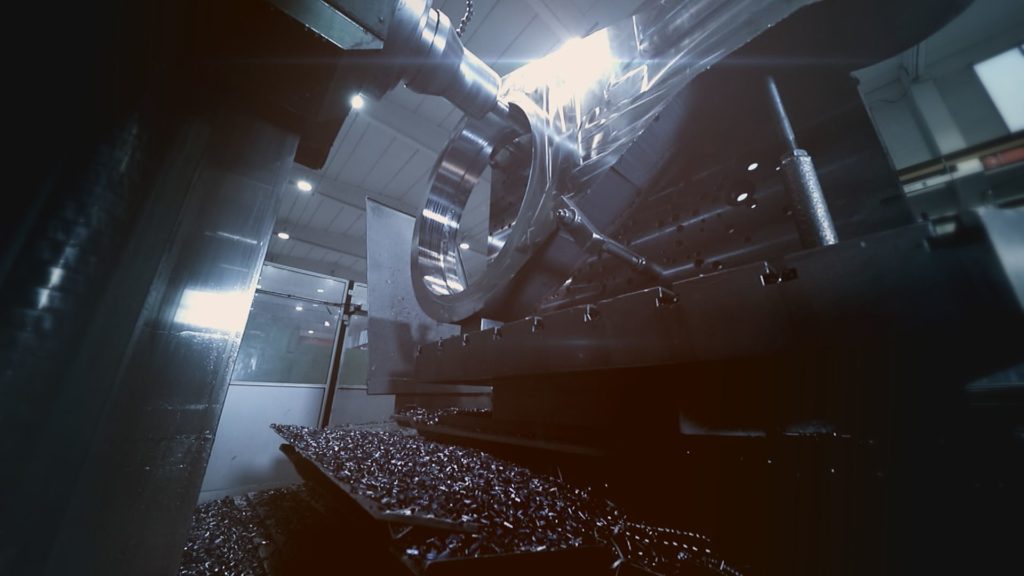
Metals hot forging process
Metals forging: hot or cold forging?
The forging by means of presses of metals commonly used for the industrial production, such as aluminum and brass, can happen in two ways.
- The first one is the cold coining, carried out, for example, on a piece that already has its own shape and that is forged through the press in such a way to calibrate it and to compact it. The cold coining is suitable, above all, for small size parts and for great production batches, such as screws. The most suitable machines for this type of process are our screw presses.
- The metals hot forging is different from the cold one because it allows to obtain high quality pieces by means of an important deformation of the starting material. With the deformation of brass, copper, aluminum by means of hot forging presses it is possible, indeed, to produce particular shapes, having very complicated structures as well. In order to achieve this forging, Mecolpress proposes, beyond the already mentioned screw presses, also the mechanical and hydraulic presses according to the different production necessities expressed by the customer.
Mechanical and hydraulic presses for the hot forging
The mechanical press can hot forge even complicated pieces. At the end of the process, the forged parts can often have some remaining flash that can be eliminated by means of a trimming machine, machinery that is part of the products range that we offer. The eccentric mechanical press with continuous cycle is recommended for the customers who have high production necessities, while the hydraulic press is more advisable for parts having very complicated shapes and that would require, otherwise, the usage of a lot of material. This type of press permits, indeed, a saving of the input material, so offering to the forger a good margin on the product cost. Moreover, by forging the parts by means of hydraulic hot forging presses, at the end of the productive cycle the parts range that can be produced without flash is much wider, thanks to a progressive and programmable application of the forces. Another characteristic of this type of presses is the flexibility, given by the wide number of available functions.
Hot forging line
For the metals forging a furnace that can be electric (induction) or gas furnace and a press are needed. This is the base productive line for the aluminum, brass, titanium and steel processing; line that can be upstream completed with a sawing machine that cuts the metal bar in billets and with a graphitizing machine, where the billets are treated with the graphite before these are inserted in the furnace, so that these absorb better the heat and that are kept lubricated. The graphitizing, that offers remarkable advantages from a productive point of view, such as a minor gas consumption in the furnace and a superior durability of the dies, is just fitting for some specific production typologies. It is not recommended, for example, for the production of parts that once forged, must be chrome plated or exposed to further particular treatments. Our sales department is at the disposal of our customers for suggesting the best forging line composition according to the product and to application field.
Hot forged metals
The customer’s choice for a specific press for his own productive cycle is based on the material typology used by the forger and on the shapes to achieve.
For the brass forging the hydraulic press is more fitting than the screw press, that is better for the forging of titanium and steel. The eccentric mechanical presses are used for all the metals, even for the copper hot forging. Our sales department is at disposal of our customers for offering the best technical solution for every specific productive situation.
For further information about hot forging machineries, please write us at sales@mecolpress.com
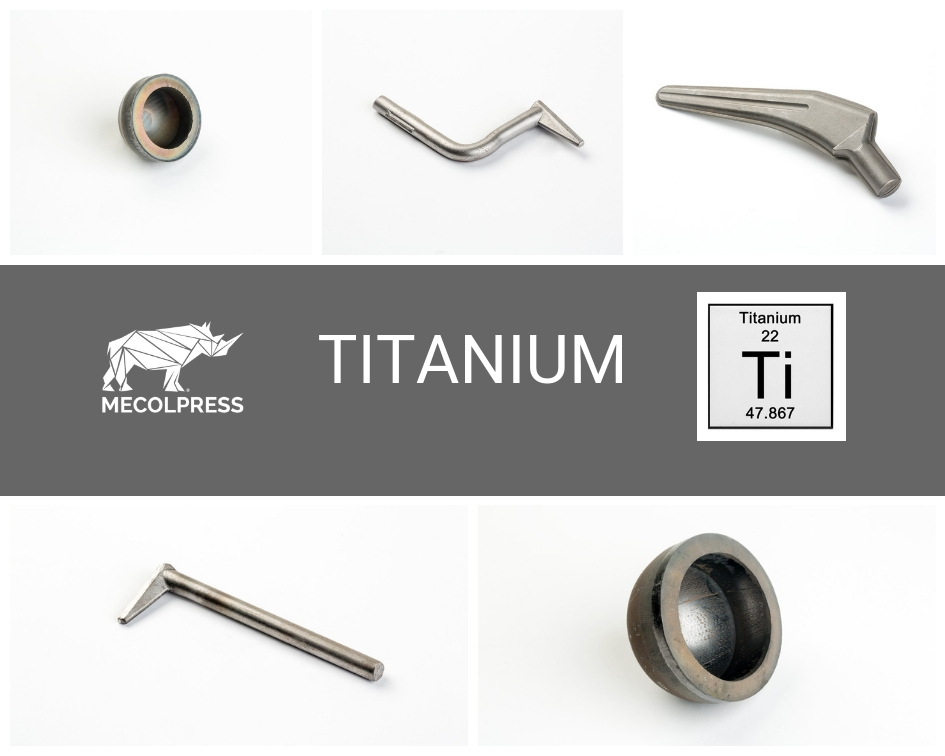
Titanium and its features
In addition to be the fourth metal for its great abundance, titanium is the ninth element in order of industrial usage. It is preceded – obviously – by aluminum, iron and magnesium.
With atomic weight of 47,88 it is light and robust: its features combine high resistance, tenacity, rigidity, low density and a good resistance to corrosion.
Its low density (about 60% of iron density) can be strengthened through alloy elements and deformation processes. It is non-magnetic and it has a good characteristic of thermal exchange. Its coefficient of thermal dilation is a little bit lower than that of the steels and it is less than half of that of aluminum. Further useful trait is the high melting point of 3135° F (1725 ° C), about 400° C higher than that of the steel and about 2000 ° F higher than that of aluminum.
Titanium can be passivated, and it resists to the attacks of acids and base better than the stainless steel. The excellent resistance to corrosion and biocompatibility, combined with mechanical resistance, make it suitable for the chemical and petrochemical, sea environment and biomedical applications.
Regarding the electrical conductivity, the titanium’s one is 3,1% of the coppers one. So, titanium is not a good electrical conductor and it offers a high electrical resistance.
For a more complete vision, here you can find a table with the summarized titanium properties:
| Main titanium’s features | |
| Specific weight | 4.5 g/cm3 |
| Density | 4500 Kg/m3 |
| Melting temperature | 1680 °C |
| Thermical conductivity | 17 W/m°C |
| Linear thermal expansion coefficient (20-100 °C) | 8.9*10-6 /°C |
| Electrical conductivity | 3% IACS (copper 100%) |
From pure titanium to the alloys
The commercially pure titanium can be classified in 4 grades, that are essentially different for:
- resistance;
- usability.
In a nutshell, when the grade raises, the first increases and the second decreases.
The titanium alloys are divided into:
- Commercially pure titanium (CO): It’s the grouping that contains the highest proportion of titanium. Typical features are the high tendency to corrosion and mechanical features of medium-low value.
- α alloys: they present good weldability and maintenance of the mechanical characteristics also at high operating temperature, thanks to the generally high content of aluminum. The usage in components particularly solicited is impeded by the fact that these cannot be submitted to any thermal treatment.
- b alloys: they guarantee the best mechanical features. These have very restricted or null weldability, these are used in the constructions of bolts and springs and in strongly solicited parts.
- α+b alloys: in the group there are the most used alloys with elevated mechanical characteristics and largely used in the production of airplane’s components.
The titanium alloys, that are rather numerous, are classified in grades.
In the traditional manufacture, as also in the 3D printing, the following types of alloys are especially used:
- the Ti6Al4V (grade 5)
- the Ti6Al4V ELI (grade 23).
Among all titanium alloys, the grade 5 is the most used: engine parts, structural parts of airplane and automotive, fastening aerospace elements, and sport equipment of high quality.
The Ti 6Al4V ELI, or simply the grade 23, is the purer version of grade 5. Thanks to its biocompatibility, to its good resistance to stress and to the low module, it can be used in dental and health care sector.
Hot and cold forging of titanium
Hot or cold forged, titanium consents to create special processing of excellent quality.
In particular, the hot process guarantees significant advantages such as:
- Increase of resistance: the longitudinal continuity, even in the critical transit area between head and stem, is kept unchanged. The raw material can be shaped, by avoiding the cuts typical of the traditional turning works. The phenomenon of detachment between head and stem decreases and it is frequent in the wrought that are submitted to excessive stress. The absence of cut fibers increases the resistance.
- Saving of raw material; optimization of costs. Swarf are not created during the process: the raw material is not wasted and the price of the product decreases.
Advantages and disadvantages of titanium usage
Advantages:
- low specific weight
- Hardness
- Resistance to corrosion
- low thermal conductivity
- Radiolucency
- Biochemical inert
- Biotolerance
- Not toxicity
- Absence of taste
- Resistance to chewing
Disadvantages:
- Not enough precise melting
- Formation of a layer of oxide on the surfaces
- Detachments of ceramic covering
- Inner porosities
- Surface porosity that allow higher accumulations of plaque than the traditional alloys.
The brief overview of information about a such promising metal (for booming sectors like health care, for example) like titanium, shows how all the above mentioned disadvantages can appear essentially just in case of melting, and so these are totally avoided by the hot forging with appropriate furnace or press, alongside an expert consultant that can address the choice of the proper machine, and suggest the working modalities and of course guarantee an impeccable customer service that avoids criticalities and tensions at the moment of operativity starting.
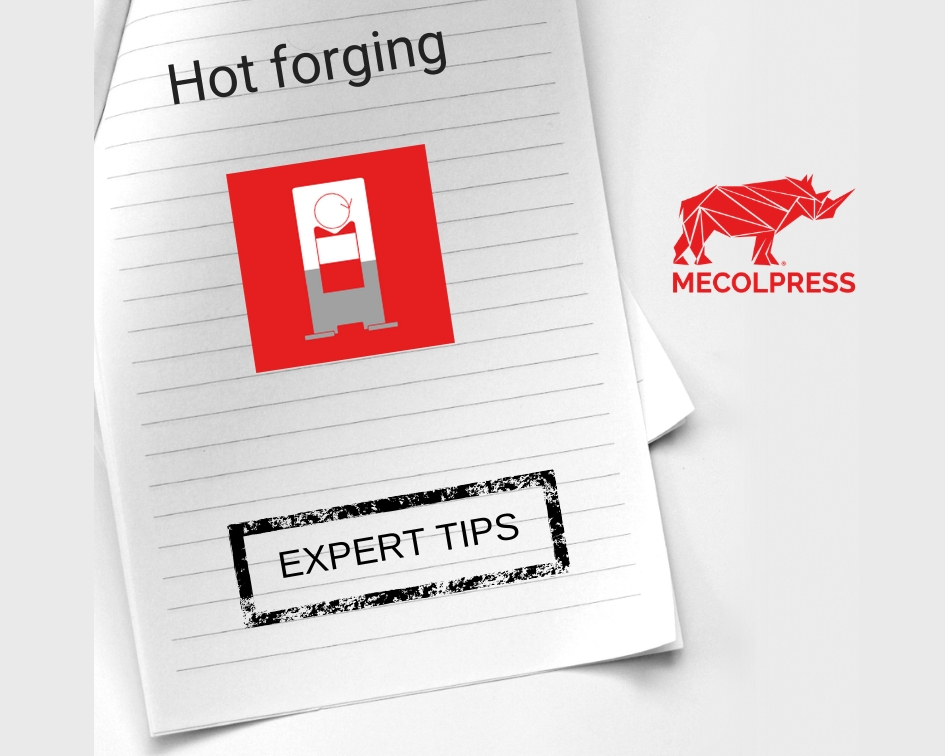
Interviews in the company: Riccardo Segreto
At Mecolpress offices we met Mr. Riccardo Segreto, person in charge of dies test and brass forging department.
What is your role in the company?
I follow the dies design for the parts forging both in brass and aluminum. Then I follow the starting test for the set-up of the die with all the necessary procedures to prepare it, to make it work properly, also suggesting the proper maintenance.
From which sector do you come from?
I have 25 years of experience in the forging sector, during which I mainly took care of brass hot forging process.
So, we are mostly speaking about brass. There are different types…
Indeed, the brass is an alloy that can be combined in many different types. Recently the tendency to produce it without lead is affirming. In this Italy follows Germany, where Ecobrass is used for a few years now, that indeed is without lead. Since the brass produced parts are largely directed to the domestic water circuits and installation, it is clear that the presence of lead represents a danger.
In the sector of taps and fittings, components, the same norms forbid the lead usage.
This is good for our health but taking off the lead from the brass alloy means to reduce its processability and this reflects on the machines, because the traditional ones are no more adequate, for example due to high cycle times or uncontrollable vibrations during the working phase.
Critical issues that arrive then to the machines. What is the answer from Mecolpress?
The company philosophy is focused on the absolute quality. Translated into concrete terms, regarding brass it means to be able to forge without flash. In this case, our hydraulic presses are very efficient. These are machines that guarantee a drastic reduction of wastes and an optimum quality of parts.
Do you speak about all parts, without differences?
Yes, the range of productions is very wide, from the ball valves to the T junctions, from components for gas plants to automotive parts. The choice is complete.
Which features contribute to the good functioning of the machine?
Reaffirming that when there is no flash some problems can be considered as to be solved, I would mention the simulation program that is a valid help for the forging of very particular parts. It is a software that, once the parametrization is given by the Mecolpress designers, shows the material flow inside the die, allowing to prevent deformation flaws in the points of impact or the brusque alterations of temperature that generate criticalities in the parts. Even if it does not replace the sensitivity of an artisan, and his experience can indicate reliably the points that need adjustments and corrections. And it allows – this is the advantage – to intervene in time.
The message of Mecolpress is above all a call to quality. How do the customers react?
Many operators of our sector are at this point convinced that our advantage incentive is the quality. They understand that to stay active on the international market, they need to be protected, and not to give up with the features for which the Italian companies are always very appreciated worldwide. It is not convenient to lose time in the battles on new orders fighting on few euros, according to us it is always better to offer a 100% quality standard. This is the distinctive characteristic of our presses and the factor that brings more satisfactions.
I mention gladly the last one: we are working hard on a test of 100.000 parts (brass sanitary taps and fittings), commissioned by a German producer that turned to us after he asked to competitors. They request to forge 100.000 parts without flash and without changing the die: we took up the challenge, but we are sure that we will win the challenge.
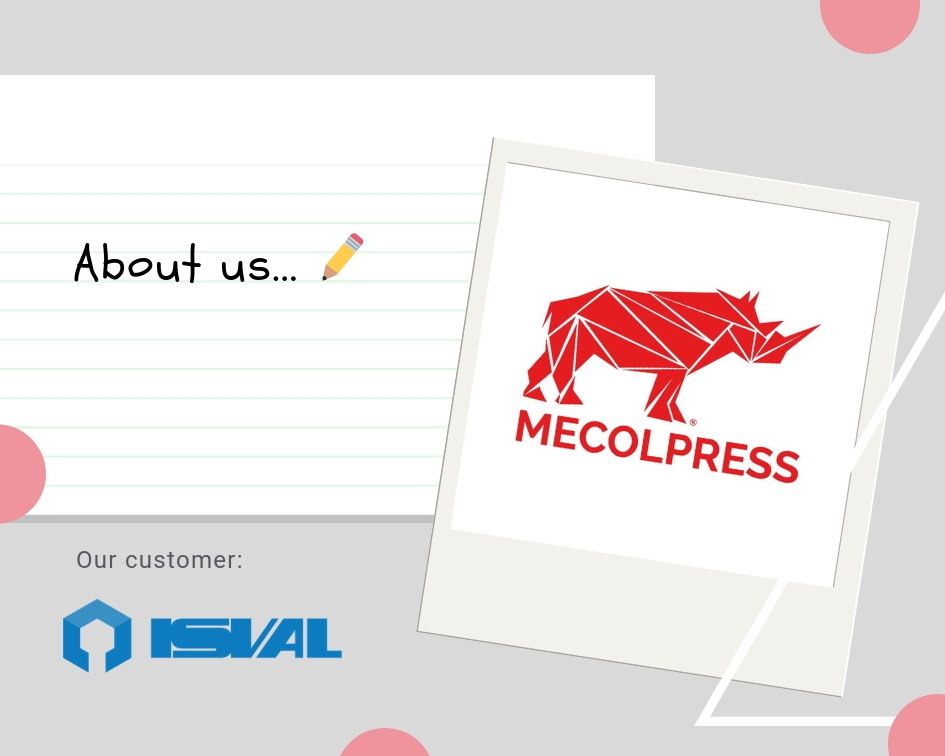
The word to an “historic” customer: Isval
Reference company in the hot stamping process sector and in the processing of brass, copper and aluminum, Isval is ISO9002 certificated since 1993 and ISO 9001 certificated since 2002. Here we met Mr. Beccalossi, customer of Mecolpress since many years.
You are a loyal customer of Mecolpress. What kind of factors is your preference for our company based on?
I would certainly speak about trust. Our relationship has strengthened during the years, and we can say that we relate to each other more as friends rather than as suppliers.
What year does the first purchase date back to?
We have to go back of several decades. We already used to buy screw presses of Dellavia and of the Swiss brand Osterwalder. Once that these brands were bought by Mecolpress, the relationship of exclusivity has remained.
Among our several different competitor, you must have evaluated also other manufacturers of similar machines … what can Mecolpress offer more than others?
Our corporate philosophy is based on the continuity, in the sense that once we have started heading in a direction, it is very difficult that we leave it. Of Mecolpress we have always appreciated the great availability and the promptness of after-sales service.
Actually, the after-sales service is one of our flagships!
I confirm it: as a customer I have always had the impression that there was a great attention for us, like a special treatment.
It must be said that restricting the suppliers number means “to deserve” the benefit of a priority assistance… Important is that the customer’s needs are met, and I have to say that for many years we haven’t had significant problems, and if we had them, they were solved very promptly.
Nowadays you have more than 20 Mecolpress machines, or anyway, machines of brands that Mecolpress represents today, Osterwalder and Dellavia. Are you particularly satisfied with some of these machines? Among screw presses, forging presses, vertical forging presses… I am very satisfied with the last type of presses, the SEO45/CVE-CS and the direct 400 model, the vertical forging SOV4 model. We just had to make some corrections to the start up of the 450 Tons press regarding the oil filtration, but it seems that this depends on a component that also Mecolpress buys.
And with regard to innovation, do you think that Mecolpress moves in an interesting way?
Yes, I would rate Mecolpress very positively regarding in this respect. I think in particular of the hydraulic Soft-Impact cushion mounted on the last purchased machine, the SEO45 continuous cycle.
I don’t know if in this panorama of great satisfaction there is place for some criticism.
If I have to find a request to make, I underline the importance for a company like ours that the expected delivery date must be scrupulously respected. It happened that some components had to be replaced, and the wait prolonged beyond the previsions, implicating for us the necessity of reviewing the production plan.
On the whole, looking at the past and at the long lasting relationship with Mecolpress, would you define it as a competent company that can keep pace with the customers, reliable but also elastic and rapid to find resources?
There is generally much more hurry than before in our world and this imposes not only to be very rapid but also very flexible regarding the needs (usually in continuous mutation) of customers. But Mecolpress is always a good interlocutor, that goes always beyond the role of a supplier. During the years we have been able to evaluate the receptiveness in taking note of a problem, or of the complex characteristics of some commissions, and the expertise made available to us, looking for the best solutions.
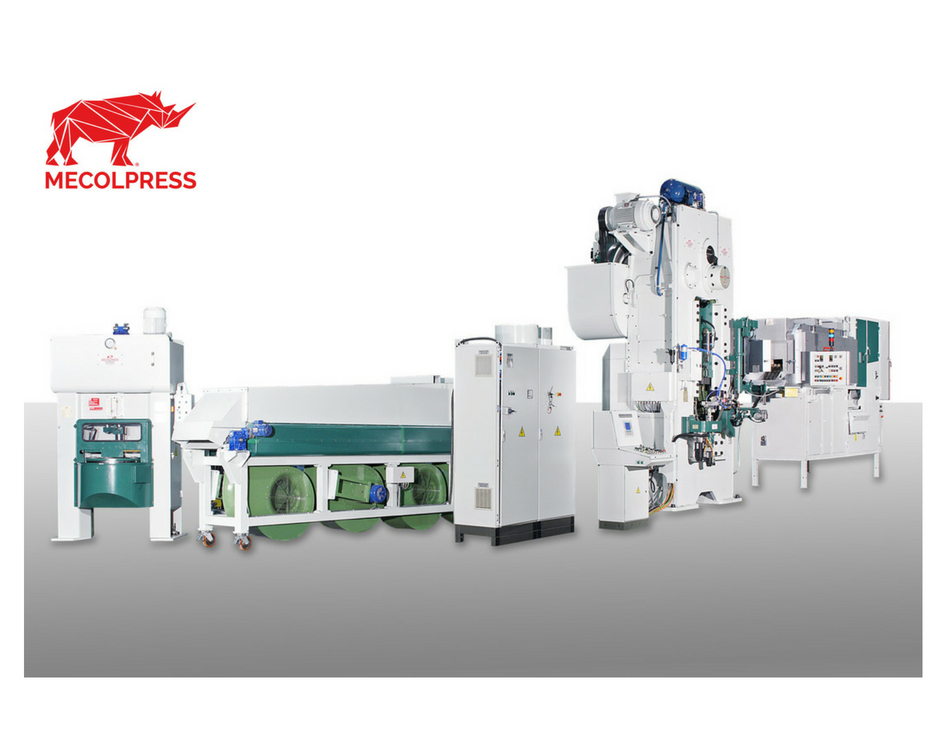
Beyond the press: great care for all the manufacturing segments
The reasons why you should appreciate (and prefer…) the modularity
In the planning and realization of different forging lines there is a common denominator, and it is the main machine, the heart of the entire project: the press.
Even if it concerns aluminum or brass forging, the press manufacturer must have a broad view, that can contemplate the entire process, from raw material bars to the finished part. An optimum press has to be born “conceived” in such a way that allows it to be able to work in synergy with the other components of the line, in order to guarantee to the user the maximum efficiency and minimum wastefulness.
The most important manufacturer’s feature that every customer who buys machineries looks for is reliability: the certainty of providing themselves with a product that “performs”, that gives satisfactions and no worries. Obviously, the moment of the initial choice of the machine is crucial, and it is determined by understanding the variety and variability of customer’s necessities over time and by the manufacturer’s competence satisfying them.
And then, steps that cannot be considered “less” crucial will arrive: installation and activation of the machine, for example. These are moments you will spend calmly, if you have someone by your side that assumes wholly the responsibility to have delivered the machine, to have verified that it works during the entire working life of the machine, as expected by the costumer, since the manufacturer is present from the start up.
Putting effort into guaranteeing all this means to be completely “master” of their own technology and of all the components that compose the line, thought as many different “segments” of a whole. We all know that presses for working and going into production need accessories, like sawing machine, furnace, deburring machine…
The skilled press manufacturer knows how to give the right relevance to these segments, by addressing the customer to the most appropriate choice (both for technical characteristics and budget characteristics) for him, by offering the most correct solutions, even if these are supplied by the manufacturer himself or if these are reachable directly from the customer by other specialized manufacturers.
The habit to think and to study every single “segment” of the forging line so that it contributes to the best, in its peculiarity, to the line efficiency has a name: modularity. The numerous satisfaction “stories” of the “Top performer” customers indicate the modularity as the most efficient way to go.
How many elements, realistically, is the press connected to? The list is long:
- traditional gas heating furnaces,
- Induction heating furnaces,
- graphitizing machines,
- arms or external Robots and of third party for loading/unloading of the machine,
- trimming presses,
- sandblasting machines,…
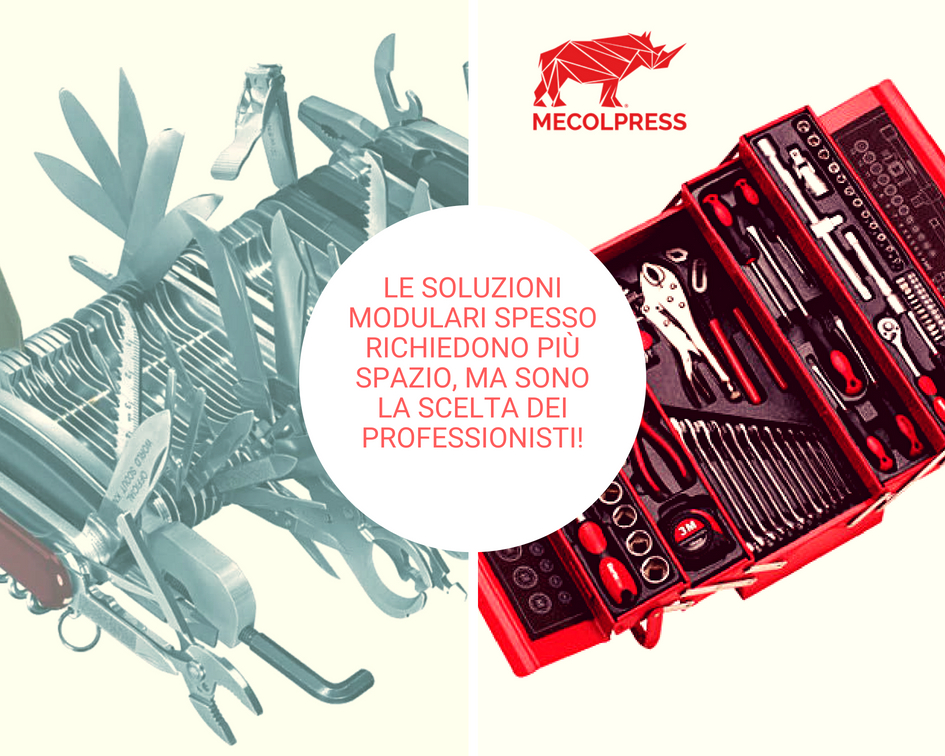
In the face of a so articulate system, the experience shows us that the “compactness” is not enough.
There is no doubt that setting up a line according to the modularity criterion will request:
- Time and patience;
- active consultation of the manufacturer;
- the need of being informed and updated on the market proposals
- Once the choices are made and components are purchased, arranging the suitable places to place them.
But let’s resume exactly from here. The possibility to “save” spaces, indeed one of the main subjects of the offers of compact lines manufacturers, seems not to be a small advantage.
However, combining many specific machines in just a “compact” solution for the above-mentioned advantage to save space risks to compromise the production results. Unfortunately, the matter of fact is that a break of just one component is enough to stop the entire “compact line” activity. So, the risk is: I have optimized the space, but the banal breakdown, for example of a blade of the shearing machine could cause the stop of the total production. At that point, having saved space will not be a great consolation, unfortunately.
The style of modularity belongs traditionally to manufacturers who knows thoroughly the problems and matters that who forges must face every day. Who has this kind of knowledge also knows well that the fact of being able to intervene in a focused and independent way on every components of the line has no price.
The modular concept, that as we have already seen, provides to have the press in line but separated from the furnace and even not in line with the other machines (as, for example, the sawing-machine or the graphitizing machine, that working separately, can create “buffer” stock of semifinished parts along the line), it allows:
▲ The biggest flexibility: the customer can choose the components he prefers (gas or induction furnace, sawing machine or seaming machine…), changing them in the future to answer to new needs, and to adapt the line layout to a company that develops.
▲ The press, since it is independent from furnaces and sawing machine, can be used in the future for forging other types of brass alloy, or copper or aluminum.
If sawing-machine, furnaces and press are “melt” in just one machine, this is not possible.
▲ Every machine can give its best (a good sawing machine can cut more billets/hour than a press can print) and does not have to adapt to the speed of the slowest machine.
▲ The line will be able to be easily adapted to non cylindrical classic billets, but also, for example pre-bent, disc shaped, billets with special contour.
▲ The best efficiency: each machine is independent, the press can forge when the sawing-machine needs a blades replacement: on the contrary, when the die on the press is replaced, the sawing machine can continue to prepare billets.
A solid knowledge of the machineries is the fundamental base that allows the manufacturer to design and propose the best technical and economical solution for the customer’s needs. Since the manufacturer is specialized in the production of presses and since he is not obliged to provide with the press its own sawing/shearing machine and furnaces and not those of anybody else, will be able to suggest to the customer the best solutions to the specified needs.
The range of the proposal is very wide, and it is possible to range from new lines (in which each component is totally new and realized by the best specific manufacturer) to lines in which one or more parts are overhauled. But is welcomed also the costumer that, choosen the press manufacturer for trust and reliability reasons, then refers to him to have consultation and indications for the other components to add so to have a complete line, “ad hoc” both for the technical production requirements and for the “wallet” ones.
Regardless of your belonging sector: thermal-hydraulic, gas, automotive, railway, biomedical, special screws, clothing components, the modularity confirms always to be the winner, exactly for the flexibility that guarantees to the forging line and for maintaining its efficiency.

